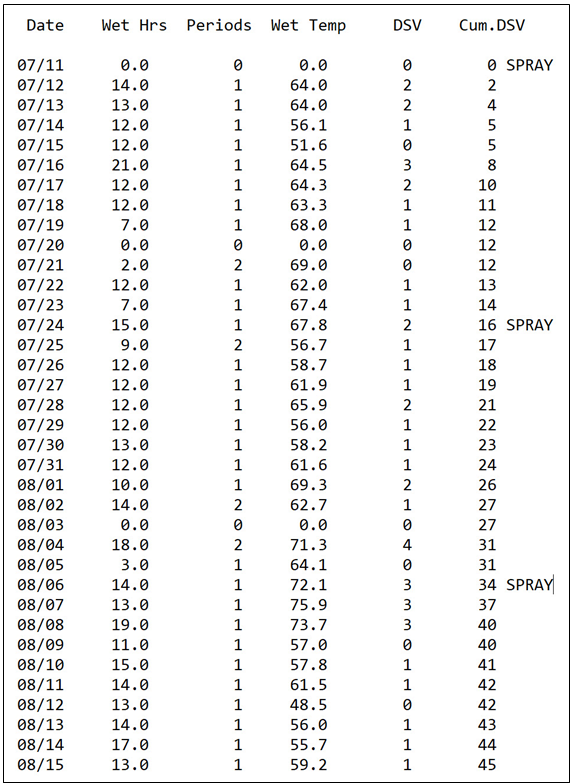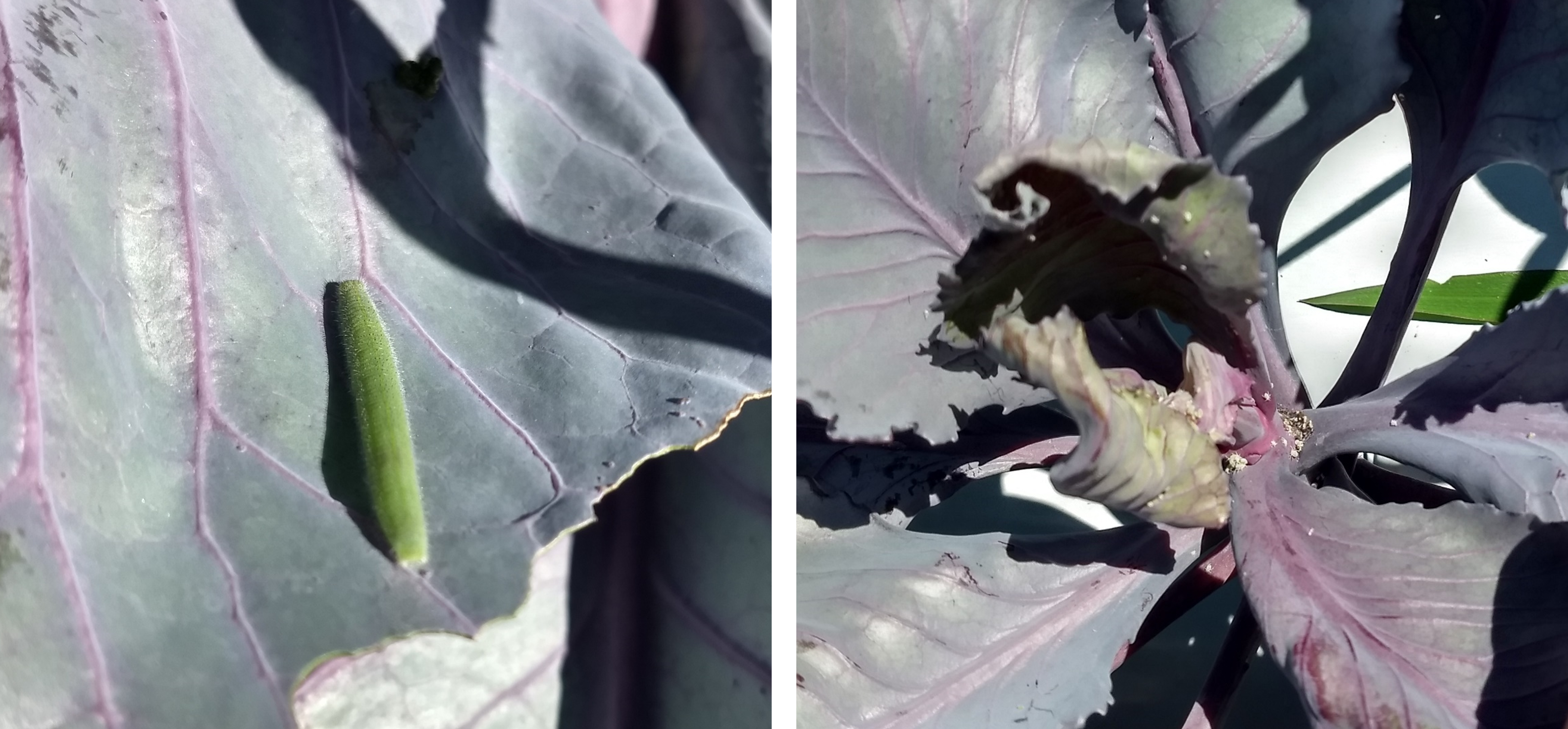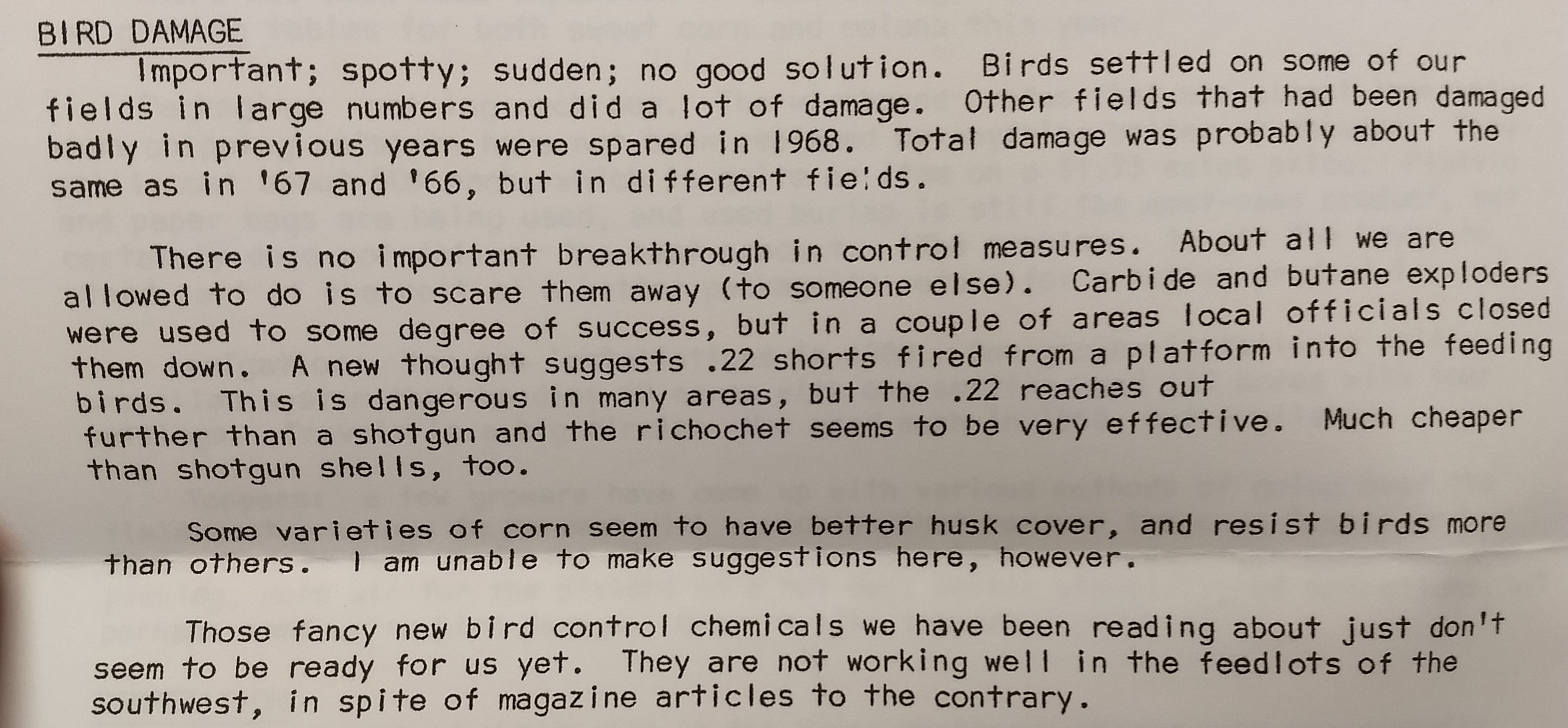Michigan vegetable crop report - August 17, 2022
Last week was ideal for disease development as Gulf of Mexico air brought high dew points.
Weather
Watch Jeff Andresen's weather update here.
We had fall-like weather for the past week, brought to us by a trough in the jetstream. Some areas in Michigan got up to 3-plus inches of rain as a band hit the west half of the Lower Peninsula but left the east relatively dry. Temperatures were 3-5 degrees below normal for the past week. Degree-day totals are still ahead of normal to the south and behind normal to the north.
The forecast calls for:
- A mostly fair and dry Wednesday and Thursday. Isolated showers possible in the afternoon and evening hours.
- Showers likely in west upper Michigan Friday, mostly fair and dry elsewhere.
- Showers and thundershowers likely late Saturday northwest spreading into lower Michigan on Sunday. Lingering showers possible again Monday southeast.
- Precipitation is forecast to total a 0.5 inch or less for the week ending next Wednesday.
- Evapotranspiration rates are expected to be lower than normal given the cooler forecast.
- Daytime temperatures mostly in the upper 70s to low 80s through Friday. Lows generally in the 50s.
- Medium range guidance generally calls for seasonable temperatures and near normal precipitation totals.
The confusing problem of blossom end rot
Seeing blossom end rot in summer squash, zucchini, or other fruiting veggies? Remember that while calcium (Ca) deficiency in the fruit may be behind the symptoms, the problem usually stems from the plant not being able to move Ca from the root zone to the fruit fast enough during development. Ca moves with water, and any environmental conditions (especially during fruit set and early development) that limit water transport from roots to fruit can promote blossom end rot. This most often involves inadequate soil moisture and high temperatures, but can also include very high humidity, flooding, or root damage.
You can’t control the weather, but ensuring adequate and timely irrigation is generally your first line of defense. Evidence suggests that foliar sprays aren’t likely to solve a blossom end rot issue, especially in field cucurbits. In crops like tomatoes, Ca foliar sprays may help in some emergency circumstances, but ideally need to contact immature fruit before symptom development. Ca is not readily mobilized from leaves to fruit.
Maintaining adequate Ca and moisture in the root zone is the best strategy. Does your soil have enough Ca? It most likely does. However, you can check with a soil test. Sandy soils with low pH are more likely to benefit from supplemental Ca, especially if soil test levels are below 300 parts per million. If your pH is low, additional Ca can be supplied by liming. If not, consider applying an amendment like gypsum to increase soil test Ca without affecting pH. Check out the MSU Fertilizer Recommendation Program for help with soil test interpretation.
Keep in mind that excessive potassium (K) fertilizer (as well as other cations like magnesium and ammonium forms of nitrogen) and high salt levels can also increase risk of blossom end rot by competing with Ca uptake. Make sure you’re not overfertilizing with these nutrients.
Using calcium nitrate (granular or via fertigation) for in-season nitrogen (N) applications can be a good way to supply N while also providing additional Ca. Supplying Ca to the roots with adequate moisture is probably more likely to benefit developing fruit than foliar applications, given the way Ca is transported in the plant.
Finally, can a leaf tissue test tell you whether Ca deficiency is the root cause of your end rot symptoms? Since blossom end rot often results from short term issues with Ca transport and localized deficiency in the fruit, an adequate leaf tissue Ca level may not tell you much. However, low tissue Ca levels (along with your soil test) may alert you to the need to address larger Ca availability issues in the soil.
For more info on this disorder and prevention, check out these recent articles from Purdue University Extension and University of Georgia Extension.
Crop updates
Asparagus
For the period Aug. 9-15, between 2-11 Disease Severity Values accumulated at seven asparagus fields where MSU has TomCast sensors. A fungicide cover for purple spot would have been due at most of these sites Monday, if nothing had been applied since Aug. 2-7. There is variability in DSV accumulations between sensor locations, proving the value of having a sensor in your own field.
Did you ever paint by numbers as a kid? TomCast is a kind of “spray by numbers” system that-like paint by numbers-is meant to take the guesswork out of spraying. It predicts how favorable weather is for purple spot each day, based on two things: leaf wetness and temperature during wet periods. When the fern stays wet longer-and it’s warm while it’s wet-a higher Disease Severity Value (“DSV”) is recorded. Values can range from 0-4; a “4” typically happens with an all day rain and warm weather. Each day’s numbers are added to a running total. An additional fungicide application is indicated once you accumulate 15 since your last spray.

Two quick notes about TOMCAST: (1) rain is not needed for disease development/DSVs, humid weather with long dew periods can be enough and (2) TOMCAST does not predict development of rust, our other main foliar disease.
A repeat from last week: Mancozeb, chlorothalonil, azoxystrobin and tebuconazole are available to protect the fern. Mancozeb and chlorothalonil are protectants with activity against purple spot and rust. You can use one or the other, but tank mixing them would not provide additional protection. Chlorothalonil is considered to have longer residual activity than mancozeb based on previous MSU forecasting research plots. When rust is a concern, one of the protectants should be mixed with tebuconazole; tebuconazole is specific for rust and is our primary “go to” fungicide for this pathogen.
Carrots and celery
A repeat from last week: This is the time of year when the carrot canopy has increased to form a relatively dense canopy that restricts air movement keeping the foliage wet for longer periods of time. The recent extended period of high humidity and rainfall along with very warm temperatures will most certainly result in an increase of Alternaria leaf blight in carrot plantings. Alternaria prefers the older, mature foliage and is a yearly problem in the state. Cercospora leaf blight can also be a problem but is less common than Alternaria leaf blight. Cercospora leaf blight can be especially damaging because it attacks the new, emerging foliage. The fungicide treatment programs for each of these pathogens are the same and include either alternating or tank mixing effective fungicides such as Merivon, Luna Sensation, the strobilurins (Cabrio is an example) with chlorothalonil. The fungicide applications can be made according to the TOMCAST forecasting program.
Cole crops
Degree days suggest the final, late-summer flight of cabbage maggot will come to an end over the next 1.5 weeks, based on weather at the Allegan, Fennville, Hudsonville and Grant Enviroweather stations. Remember this is just a forecast, and that activity will occur after peak as well. Assuming the forecast is accurate, damage by maggots-hatching from eggs laid by these flies-should become more visible in the last two weeks of August, and the last large batch of maggots would be completing development in the first half of September (based on these weather stations). Read more about cabbage maggot control in root crops at bit.ly/cabmaggot.

Cucurbits/pickles
All cucurbits are being harvested now, including a few rogue ripe pumpkins heralding the fall season. At a field night last week a question was asked about yellowish fruit that seemed a little soft, with pliable handles. Were they being aborted? The grower brought some basketball-sized fruit to show, and it was determined that no, they were just still young supple fruit putting on size and coloring. However, when fruit are smaller than a softball these same sort of symptoms could indeed indicate fruit abortion. Abortion of small fruit is a natural part of pumpkin production. Plants overset fruit and have to let some go.
Do not be afraid of crushing fruit when spraying. In many cases you stand to lose more fruit by not spraying than by spraying. Remember, plants overproduce, and when you run over a developing fruit, there are plenty more ready to take its place.
It is a good idea to maintain powdery mildew sprays for all vine crops, downy mildew sprays for cucumbers and melons, and Phytophthora sprays on vine crops grown with a field history of the disease.
Also, see the section above on blossom end rot for squash-relevant information.
Fruiting vegetables
The full suite of fruiting vegetables are being picked now, along with colored peppers. Eggplants, peppers, and tomatoes in southwest Michigan are exhibiting symptoms that appear to be related to high heat at bud-formation. The cheese wheel or pin cushion shaped peppers, and the eggplants and tomatoes with “noses” growing out from their caps are the signs. Those funky shapes are predetermined by the developing bud before flowers even open. When daytime temperatures are over 90 F and nighttime temperatures are over 70 F for several days or more during the preflowering period, when flower buds are just forming, the fruit that develops from those flowers tends have more segments that squeeze out in strange ways in eggplant and tomato, and result in blockier or flatter growth in pepper, sometimes creating fruit with more five or more lobes.
According to MSU Enviroweather data in Benton Harbor, 13 of the first 14 nights of July had overnight temperatures over 70 F, with several nights in a row July 3, 4, 5, and July 7 with temperatures over 80 F. This could be one explanation for the increase in misshapen fruit being harvested now.
Sweet corn
It is possible that earworm activity was spotty in recent days. An Ohio report showed a spike in capture in one county in recent days, while numbers were lower at other locations. Similarly, as of Monday earworm continued to be captured at about one moth per night in an Oceana an Ottawa county trap MSU Extension is checking, while zero were captured in a southwest Michigan trap. However, crop scouts have observed significantly higher catches at another location, so… that’s why it is worth having your own trap! Regardless, it is worth protecting silking sweet corn at captures of 1 per night, especially as field corn finishes silking. When and where captures increase, spray intervals should be tightened accordingly.
Here is a repeat on control options from a previous report: Past work at Ohio State University suggested that pyrethroids can be effective when trap catches are low, check out this helpful article. There are a wide variety labeled, including old standbys like Warrior II, Brigade, Baythroid, Mustang Maxx, Hero and their generics. These can provide affordable control when pressure is not high. When trap captures are higher, products containing the active ingredients chlorantraniliprole or spinetoram are helpful. There are both one-active versions of these (e.g., Coragen and Vantacor for chlorantraniliprole, Radiant for spinetoram) as well as pre-mixes with pyrethroids (e.g., Besiege, Elevest) or other insecticides (e.g., Intrepid Edge). Check pricing, check traps, spray, and hope for the best!
Now that field corn is getting past the milk stage, bird pressure is returning to sweet corn fields. I thought it would be pertinent to share a piece of history which still resonates today, from an MSU research station report in 1968. Today we also have lasers, squawk boxes, air-inflated tubemen, compact discs, reflective ribbons, and predator balloons which still leave much to be desired. At GLEXPO this year, we’ve invited Page Klug from the USDA to share some of her data on using drones and RC aircraft for dispersing bird flocks. Perhaps this will work.

Events
- Aug. 23: Plant Diagnostic Day at the Saginaw Valley Research and Extension Center. The center is located at 3775 S. Reese Road in Frankenmuth.
- Aug. 24: Blueberry field day at the Trevor Nichols Research Center. The center is located at 6237 124th Ave. in Fennville, Michigan.
- Aug. 25: 2022 Tile Drainage Field Day at 13000 Bird Lake Rd, Camden, MI.
- Sept. 8: Field Day at the Northwest Michigan Horticulture Research Center. The center is located at 6686 S. Center Highway in Traverse City and will highlight Michigan fruit advancements.
- Sept. 8: Oceana Research Tour featuring asparagus and carrots. Call 231-873-2129 for more details.
- Sept. 14: Mechanical Weed Control Field Day at the Southwest Michigan Research and Extension Center. The center is located at 1791 Hillandale Road in Benton Harbor.
This work is supported by the Crop Protection and Pest Management Program [grant no 2021-70006-35450] from the USDA National Institute of Food and Agriculture.



 Print
Print Email
Email

